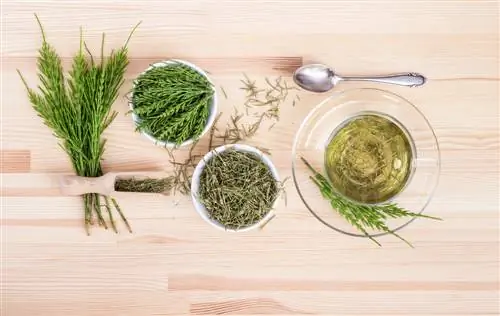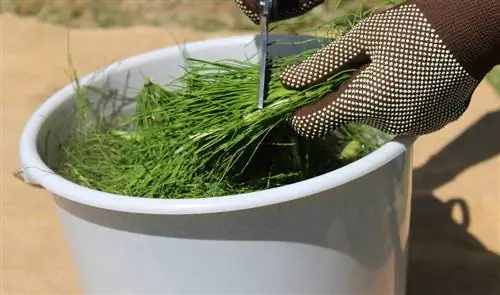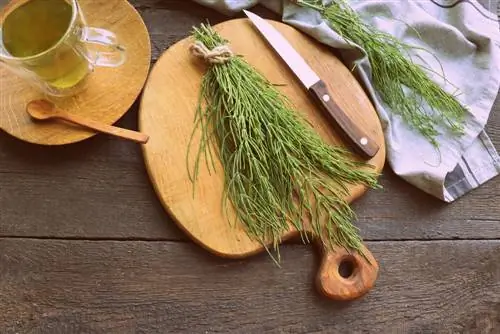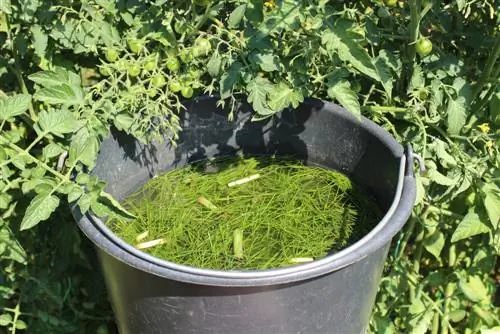- Author admin [email protected].
- Public 2023-12-16 16:46.
- Last modified 2025-01-23 11:22.
Field horsetail is one of the oldest plants on earth. And accordingly he is also tough to survive. If you want to banish him from your lawn, you have to do something to counteract his primal powers in the truest sense of the word. We'll show you how you can get to the living fossil.

How can you effectively combat field horsetail?
To effectively combat field horsetail, we recommend loosening the soil, digging up roots and liming the soil. Cutting off or pulling out the shoots is suitable for combating symptoms, whereas herbicides or weed fleece are usually ineffective.
The botanical definition of field horsetail
In order to know how best to deal with field horsetail in the garden, it is an advantage if you know it well. So let's first take a quick 360° look at it and put its key botanical data on the table.
The field horsetail forms different shoots in two phases. In spring, around March to May, it forms 5-20 cm high, fertile, light brown spore shoots with sporangia (spore containers), through which it reproduces generatively. After releasing their spores within about a month, they die and make room for the infertile/sterile, light green shoots. These are particularly noticeable because of their whorls of branches arranged in tiers. The shoots are about 30 to 50 centimeters high and are light green in color.
The field horsetail has several common names, the best known of which is probably 'horsetail'. It belongs to the horsetail genus, botanically Equisetum, and to the horsetail family, botanically Equisetaceae. These in turn originate from the order Equisetales, which belongs to the class Equisetopsida. At the very beginning of the family tree the threads converge with the ferns.
Excursus
The paleobotany of the field horsetail
The taxonomy of the field horsetail, which is consistently permeated by the name 'horsetail', shows how effective it has been for survival throughout the history of the earth. Like ferns, they represent a direct connection to the beginnings of our planet's flora. In contrast to today, horsetails once formed a much more powerful and species-rich family of plants. The first horsetails are documented for the Upper Devonian geological period around 375 million years ago. At that time, some horsetail species grew into huge, tree-shaped growth forms up to 30 meters high with trunks up to a meter in diameter.
One characteristic that has certainly contributed to the field horsetail's amazing survival efficiency is its rooting in the soil. Its branched and hairy rhizomes penetrate up to 1.60 m deep into the ground, ensuring a reliable supply and strong vegetative reproduction. An advantage for the plant, a horror for the gardener.
Fight horsetail effectively
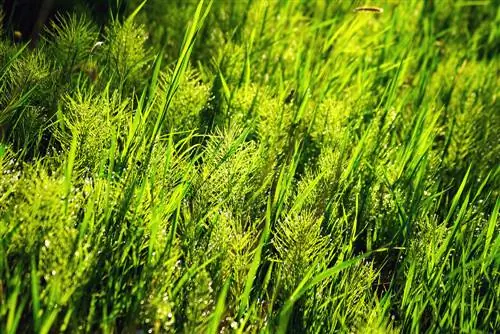
Once you have field horsetail in your garden, you can look forward to a long relationship
In fact, the field horsetail has a lot to offer the hobby gardener thanks to its survival strategy that has been tried and tested for thousands of years. Because it reproduces relentlessly and is difficult to control, it is considered one of the most unwelcome weeds - both in private gardens and in agriculture. Depending on how ambitious and we althy you are, you can try to permanently eradicate the field horsetail or be content with combating the symptoms. Here is an overview of the possible methods and their advantages and disadvantages:
| Soil loosening | Dig up roots | liming | Regular shoot removal | |
|---|---|---|---|---|
| Advantages | Durable solution, the weeds are deprived of their preferred soil properties in the long term | Long-lasting solution, immediate control of the plant | Durable solution, also displaces moss and benefits lawn grass | Little effort required, shoots can be retained and used for various medical, cosmetic and horticultural home remedies |
| Disadvantages | Very laborious and energy-intensive, motorized device may be necessary | Strong, laborious, root remnants sprouting again are virtually unavoidable | Only gradual and not particularly intense effect, correct dosage a bit difficult | Only symptom control, regular implementation required |
Fighting the causes
The field horsetail is largely resistant to superficial cutting or tearing, covering with weed fleece and chemical herbicides. At least the results are not permanent, because new shoots keep sprouting from the rhizome roots. If you want to get rid of him for good, you have to look at other sides. The following methods are most effective:
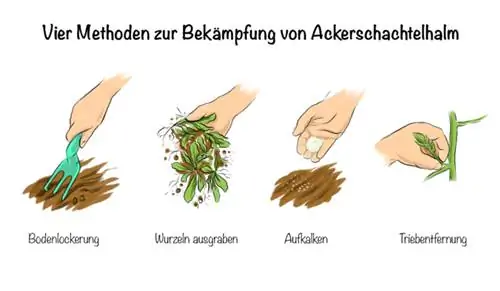
- Soil loosening
- Dig up roots
- liming
Soil loosening
We now know that the field horsetail's greatest asset is its strong rootstock, from which it can regenerate easily. In order to combat it sustainably, this is exactly where we have to start. With its deep roots, field horsetail prefers to anchor itself in firm, loamy soil that holds a lot of water. That's why they often occur in areas that either naturally have such soil conditions or in areas that are compacted by heavy vehicles.
In order to literally get to the root of the field horsetail problem, it makes sense to loosen the soil. This deprives the plant of its preferred basic requirements. In agriculture, deep chisels are used for preventative control, which use their long metal claws to loosen up the soil deeply. Even in private areas, especially in larger areas, you can use a motorized device such as a motor hoe (€139.00 on Amazon) instead of a spade. Alternatively, you can also use deep-rooted, structure-loosening plants such as lupins. This method requires more patience, but less effort.
Loosening the soil down to the lower layers is particularly worthwhile for newly created garden plots. These are often heavily compacted by construction vehicles from house construction and generally benefit from complete loosening of the soil in the following years.
Dig up roots
When digging the soil mechanically or manually, you should also remove the roots of the field horsetail. Try to be as thorough as possible, because, as with other strong-rooted and survival-oriented plants (such as ivy), new shoots can also sprout from smaller residues.
liming
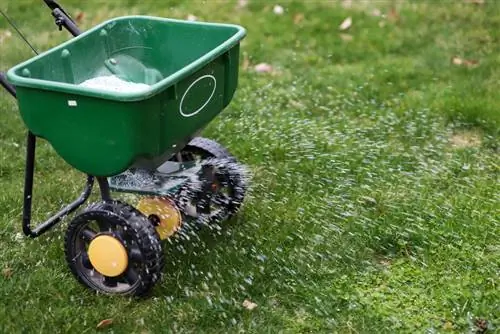
Lawn lime also curbs the growth of field horsetail
Another way to permanently contain field horsetail is to lime the soil. It no longer thrives as well in a slightly acidic to alkaline environment. Liming is particularly advisable if the weeds have spread through the lawn. A neutral to alkaline pH value can also suppress moss, while benefiting lawn grasses and helping them to become more dominant. That's why liming is generally recommended as a means of strengthening the lawn.
However, you should not just start liming, but rather dose it carefully. An environment that is too alkaline is not good and can actually promote moss again. It is advisable to take a soil sample first. You can purchase appropriate test sets from gardening stores for little money. Since field horsetail prefers to grow on compacted soils, a low pH value is likely, as such soils easily acidify. The pH value of compacted clay soils should be at least 6.5.
Symptom control
If the energy-intensive digging or the patience-demanding tillage with lupins or lime is too laborious for you, you can also keep the field horsetail under control superficially.
However, only mechanical methods are suitable for this, i.e. pulling out or mowing the shoots. Covering with weed fleece or biological and chemical weed killers are not effective on horsetail.
If you cut the field horsetail, you can also use it. Because it has long been valued primarily as a medicinal plant.
Useful properties of field horsetail
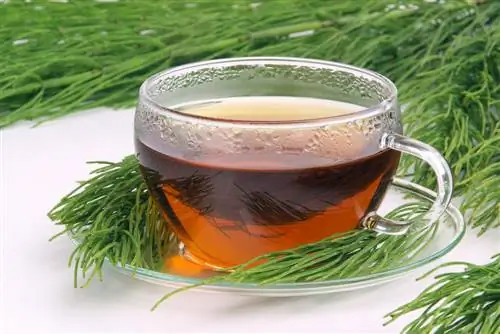
Field horsetail tea is delicious and he althy
Whoever you cannot defeat, you should make friends with.
This folk wisdom advises to cooperate elegantly and cleverly with adversities and opponents instead of fighting them doggedly and without any hope. In this respect, it can be easily applied to the fight against field horsetail. Because there are definitely some reasons to consider him a friend.
About 2000 years ago, humanity learned to use the valuable ingredients of field horsetail for their own benefit. To this day, the plant is used in the pharmaceutical, cosmetic and even horticultural sectors. The substances from which you can benefit are primarily silica, flavonoids, potassium, carboxylic acids and glycosides.
Seen in this way, weeding can become a real gift and cutting can become a grateful harvest instead of an angry fight.
Pharmaceutical use
Famous doctors, botanists, pharmacists and general scholars such as Dioscorides, Pliny, Paracelsus and Kneipp have contributed to the therapeutic role of horsetail that is now firmly established. Until now, the following characteristics are particularly appreciated:
- astringent effect
- cleansing effect
- Anti-inflammatory
- Immune stimulation
Field horsetail is particularly effective as a cleansing therapeutic agent for the blood, kidneys, bladder and stomach. It regulates the blood balance, improving the situation in the event of bleeding or anemia, and helps flush out ulcers and deposits in internal organs. Its soothing effect on rheumatic diseases and chronic coughs has also been confirmed. Anyone who has weak tendons or tendons that are heavily strained as a result of sports can also benefit from the connective tissue-strengthening effect of field horsetail. Externally, field horsetail develops its positive properties on inflammatory wounds and swellings.
For internal applications, horsetail is mainly used in the form of tea. To do this, add about 8 teaspoons of chopped, green summer shoots to 500 milliliters of hot water, boil the whole thing and let it steep for 30 minutes. This is the best way to dissolve the silica. As a cure, drink 3 cups per day for 4-6 weeks; for rheumatism sufferers, the tea is also recommended as a long-term drink.
You can also use this tea for external applications, for example by soaking cloth wraps in it and placing them on wounds that heal poorly. If you have inflammation in the mouth, you can use it to rinse your mouth and gargle with persistent coughs. Poultices can also be prepared for swelling.
Field horsetail in cosmetics
In the cosmetic sector, field horsetail is above all a valuable supporter of connective tissue. Its high content of silica, flavonoids and trace elements benefits skin, hair and nails, strengthens and firms them and can therefore be considered an effective, natural beauty and anti-aging agent.
The tea described above is also an effective preparation method for these cosmetic purposes. When applied externally as well as internally, it develops its effect on strengthening connective tissue.
Plant care with field horsetail
The horsetail can be transformed from a nuisance to a beneficial insect even in the garden. Its high silica content also strengthens the cell structure of useful and ornamental plants, forms a crystalline protective layer on the leaves and therefore makes them less vulnerable to fungal diseases and sucking pests. Powdery mildew, star sooty mildew or rose rust and aphids can be effectively prevented with a home-made broth, manure or a cold extract from field horsetail.
For the broth, soak 750 grams of chopped horsetail herb in 5 liters of water for 24 hours. Then bring the mixture to the boil, let it simmer for half an hour and then cool. Dilute the strained brew with water in a ratio of 1:5. Filled into a flower syringe, you can use it to regularly treat plants suffering from fungal diseases. As a preventive measure, it is best to spray once a week in spring before the leaves emerge.
After the leaves have sprouted, the treatment can be continued as an acute measure, although a lot of thoroughness is required for a successful effect. This means that the leaves of the plant must always be sprayed completely and dripping wet and after rain and long periods of intense sunlight they always need to be sprayed again.

Frequently asked questions
How do I recognize field horsetail?
Field horsetail appears for most of the growing season with light green, 30 to 50 cm high shoots on which there are slightly upright, whorily branched, tiered branches. The stems are 3-5 millimeters in diameter, ribbed and hollow inside. In spring, around March to May, the field horsetail appears with fertile shoots in a light brown color, on which there are 4 to 6 sheaths instead of the branch whorls. On top is a spike of sporangia, which is similar to spike flowers such as those of ribwort plantain.
What is the most effective way to combat field horsetail?
Field horsetail has very deep roots and can therefore only be contained permanently with a lot of effort. You can expect the most long-term success if you loosen the soil, because the weeds need dense, loamy soil. In the course of this, the roots should also be dug out as completely as possible. Liming the soil is also helpful for long-term control. The only way to combat symptoms is to cut off or pull out the above-ground shoots. Herbicides or weed fleece remain largely ineffective.
How to make tea from field horsetail?
Tea made from field horsetail has many positive properties and can be used for both medicinal and cosmetic purposes. To prepare it, cut a good handful of the sterile, green field horsetail herb into small pieces and add 8 teaspoons of it to half a liter of hot water. Then you boil the whole thing and let it steep for half an hour.
Is field horsetail poisonous?
No, field horsetail, i.e. Equisetum arvense, is not poisonous. However, there is a fairly high risk of confusion with the poisonous swamp horsetail.
What can field horsetail be confused with?
Field horsetail can easily be confused by laypeople with the related swamp horsetail. Not only does it look very similar to its own species, but it also grows in similar locations and sometimes the two species even keep each other company. In general, however, swamp horsetail is found in wetter areas than field horsetail. However, it is easier to identify the species by their appearance, or more precisely by the cross-section of the stem. It is significantly larger in field horsetail than in swamp horsetail.

